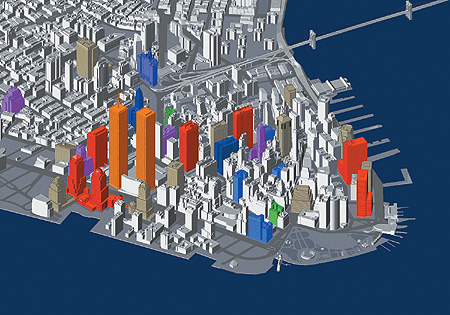 | |||||||||||||
|
5) DOWNTOWN NEW YORK
Lower Manhattan's high-rise history spans the century and features extant eighteen Jumbos and four Super Jumbos -- the richest concentration and range anywhere. New York's first skyscrapers rose around City Hall and Park Row and on Lower Broadway. In the 1880s and 1890s, when major office buildings contained around 100,000-150,000 ft2, the threshold for a Jumbo was 250,000 ft2. Only two met the standard: the Bowling Green Building at 11 Broadway and 15 Park Row (in green on the map). From 1900-1920, the standard rose to 500,000 ft2. Of the nine Jumbos of the period, seven still stand (in blue on the map), including the first Super Jumbos: the Woolworth Building and the mammoth Equitable Building at 120 Broadway, which with 1.7 million ft2 ranked as the world's largest office building from 1915 until the Empire State in 1931. In the boom cycle of the 1920s, the benchmark for a Jumbo increased to 1 million ft2. Of the dozen buildings city-wide that qualified (in purple on the maps), only four were downtown where large sites were difficult to assemble in the prime area of the historic financial district. Since 1950, although midtown experienced the most development overall, downtown has been the site of the greatest number of new buildings exceeding 2 million ft2:--seven Jumbos (red) and two Super Jumbo (orange) to five in midtown. In the late 1960s and early 1970s, the period of the biggest buildings of this century, New York's largest projects were located downtown. From 1967-1973, the average area for a new building in Lower Manhattan, was an astonishing 1,448,000 ft2, while in midtown, it was 985,000 ft2. The buildings in beige are those built after 1950 that contain between 1-2 million ft2. |
|||||||||||||
|
P6 |
||||||||||||